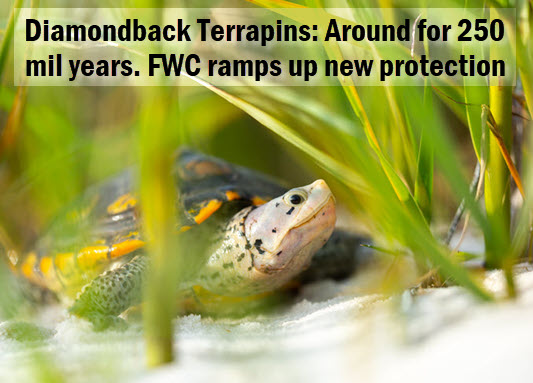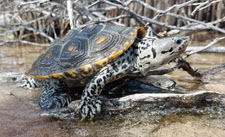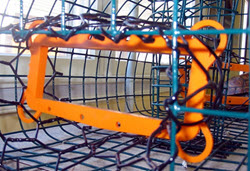Diamondback Terrapins: New Protection From FWC
Posted March 11, 2022 07:50 am

Photo: FWC by Britt Brown | Columbia County
Observer graphic
Florida – At its December 2021 meeting, the Florida Fish and Wildlife Conservation Commission (FWC) approved regulation changes to help diamondback terrapin conservation by preventing them from being collected from the wild and drowned in crab traps.
The Diamondback Terrapin: Turtles, tortoises or terrapins?
Since before the dinosaurs – turtles have been around for 250 million years with the same basic body design.
What they are called depends not only on where they live, but also where you live.
In the United States, turtles, tortoises, or terrapins are commonly called turtles. The term tortoise is strictly for terrestrial species which live on land. Tortoises have stumpy, elephant-like hind feet and no webbing between their toes. Terrapins live in brackish water, water that is only slightly salty. Sea turtles live in saltwater.
Diamondback terrapins are believed to be the only turtle in the world that lives in brackish water. They are found from Cape Cod southward along the Atlantic coast to the Florida Keys and westward along the Gulf Coast to Texas.

FWC photo by Kevin Christman
Diamondback terrapins are named due to the diamond-shaped scutes, or bony plates, on their carapace, the upper shell. Their scutes are unique to each individual, just like fingerprints to humans. Within the scutes are white, green, and black concentric circles. The color of the carapace varies greatly from grayish to brown to nearly black. The plastron, lower shell, is yellowish or greenish.
The diamondback's hind feet are large and webbed, making them excellent swimmers.
Turtles do not have teeth, but their upper and lower jaws form a strong horned beak. Their powerful jaws are heard making a popping noise as they eat snails and mollusks in the marsh.
Throughout their range, diamondback terrapin populations are in decline due to habitat loss, unsustainable collection from the wild due to growing popularity in the global pet market, predation, road mortality, and propeller strikes.
Because of overlapping habitats, there is also a potential for terrapins to be accidentally killed in blue crab traps.
In Florida, diamondback terrapins live in brackish water habitats, including salt marshes, barrier islands, mangrove swamps, tidal creeks, and rivers. They eat a variety of foods, including snails, crabs, clams, mussels, worms, fish, and plants.
Five of the seven subspecies occur in Florida, three of which can be found nowhere else in the world. More information on diamondback terrapins can be found at MyFWC.com/Terrapin.
Because of the threats to the diamondback throughout its range, it is listed as a species of special concern in many states.
New Regulations in Florida
As of March 1, 2022, all collection and possession of diamondback terrapins are prohibited except for scientific research with a valid permit. People who currently possess diamondback terrapins as personal pets may legally keep these animals, but must obtain a no-cost Personal Possession permit by May 31, 2022.
Individuals or institutions who keep diamondback terrapins for public display, education, outreach, or similar conservation-based programs must obtain a no-cost Exhibition and Education permit. Permit guidance and application information are available at MyFWC.com/FreshwaterTurtles.
 In
addition to this new rule, the FWC is
helping conserve terrapins by requiring all
recreational blue crab traps have rigid
funnel openings no larger than 2 inches by 6
inches at the narrowest point or 2-inch by
6-inch bycatch reduction devices installed.
This change, which takes effect March 1,
2023, will reduce the number of terrapins
accidentally captured in crab traps.
In
addition to this new rule, the FWC is
helping conserve terrapins by requiring all
recreational blue crab traps have rigid
funnel openings no larger than 2 inches by 6
inches at the narrowest point or 2-inch by
6-inch bycatch reduction devices installed.
This change, which takes effect March 1,
2023, will reduce the number of terrapins
accidentally captured in crab traps.
For more information on these diamondback terrapin regulation changes, visit MyFWC.com/FreshwaterTurtles.
-------
Information for this article provided by the Florida Fish & Wildlife Commission. Additional information from Meigs Point Nature Center.
